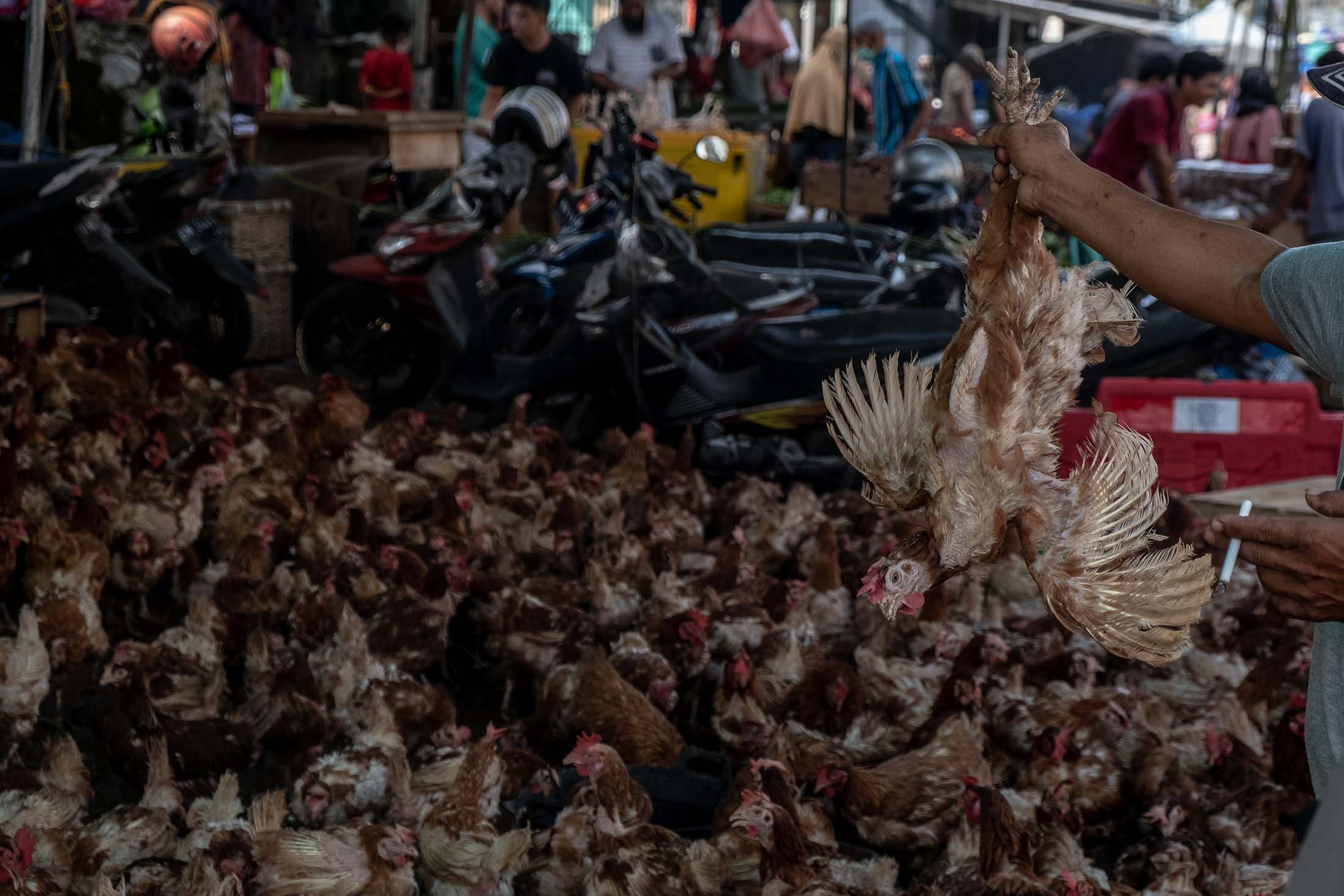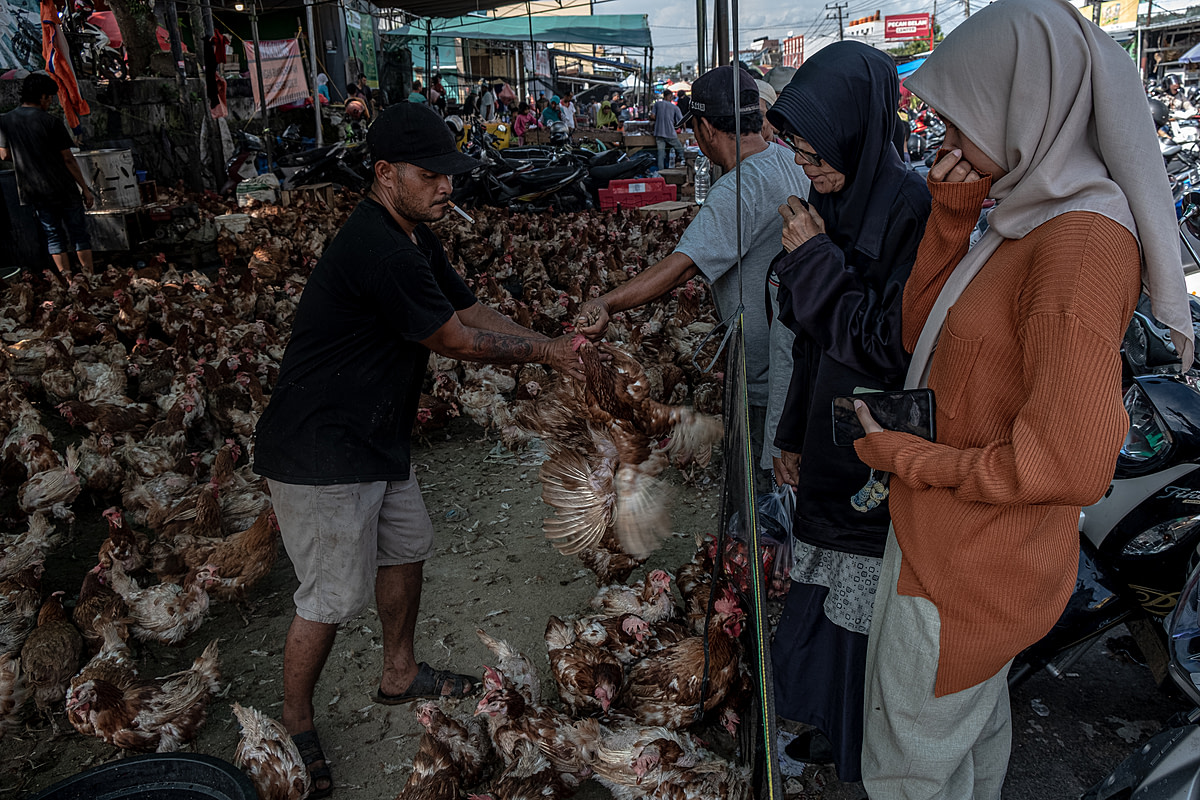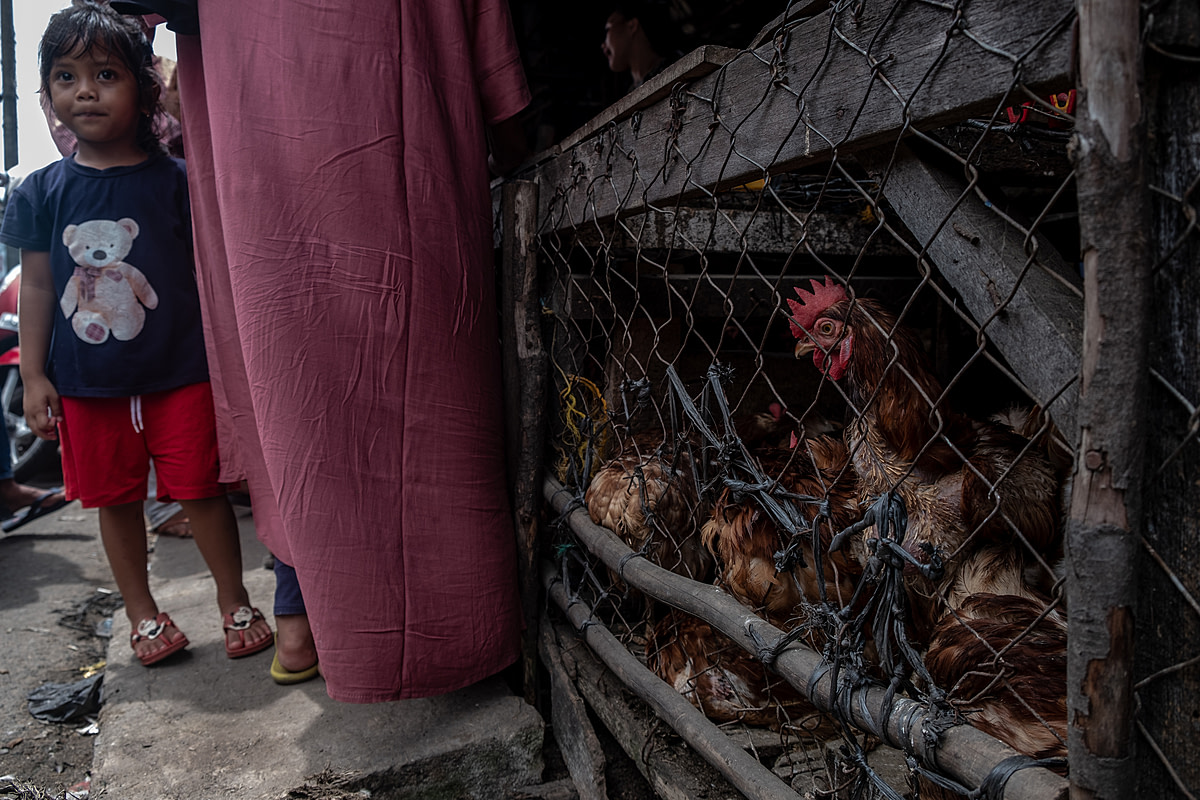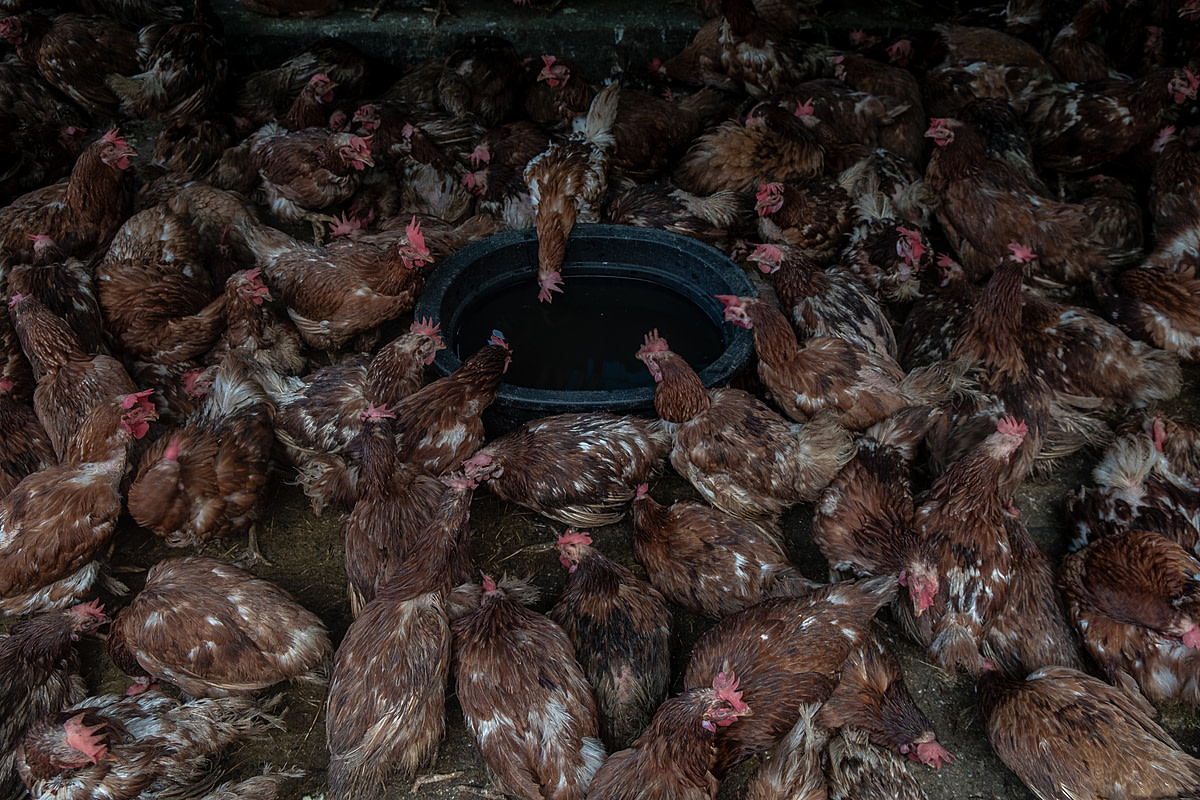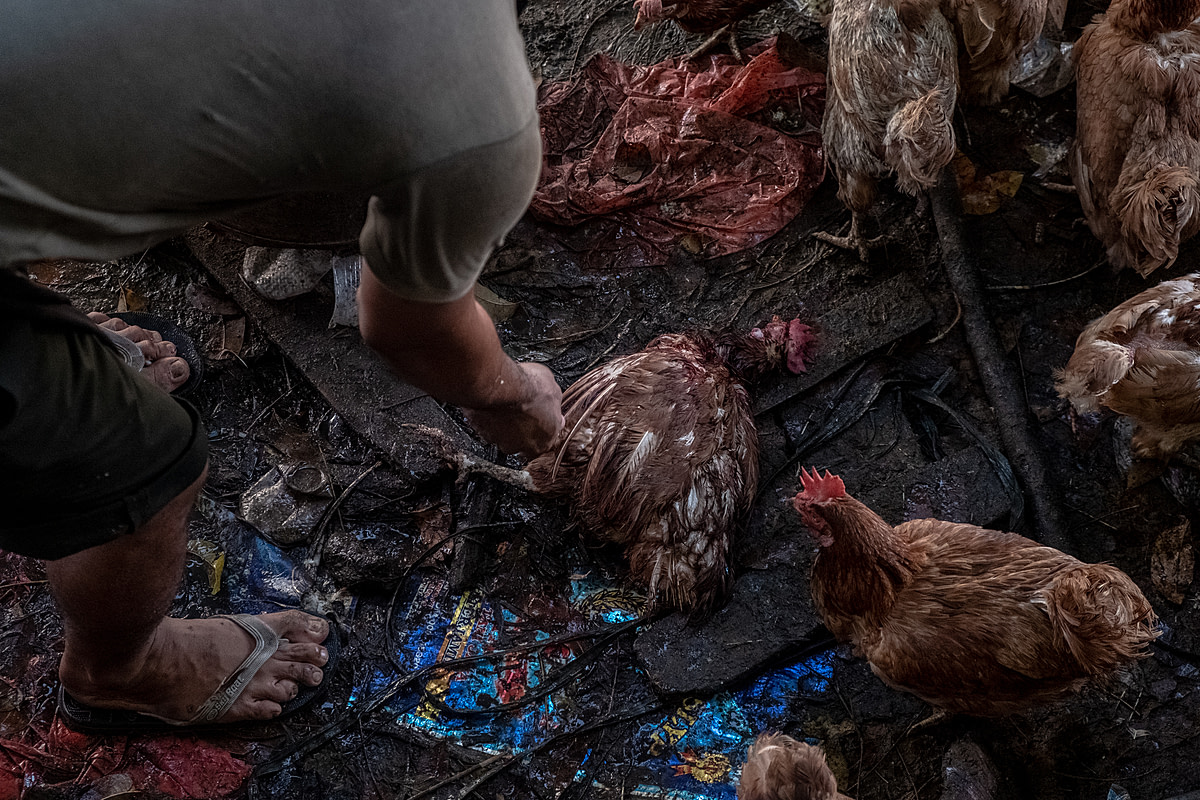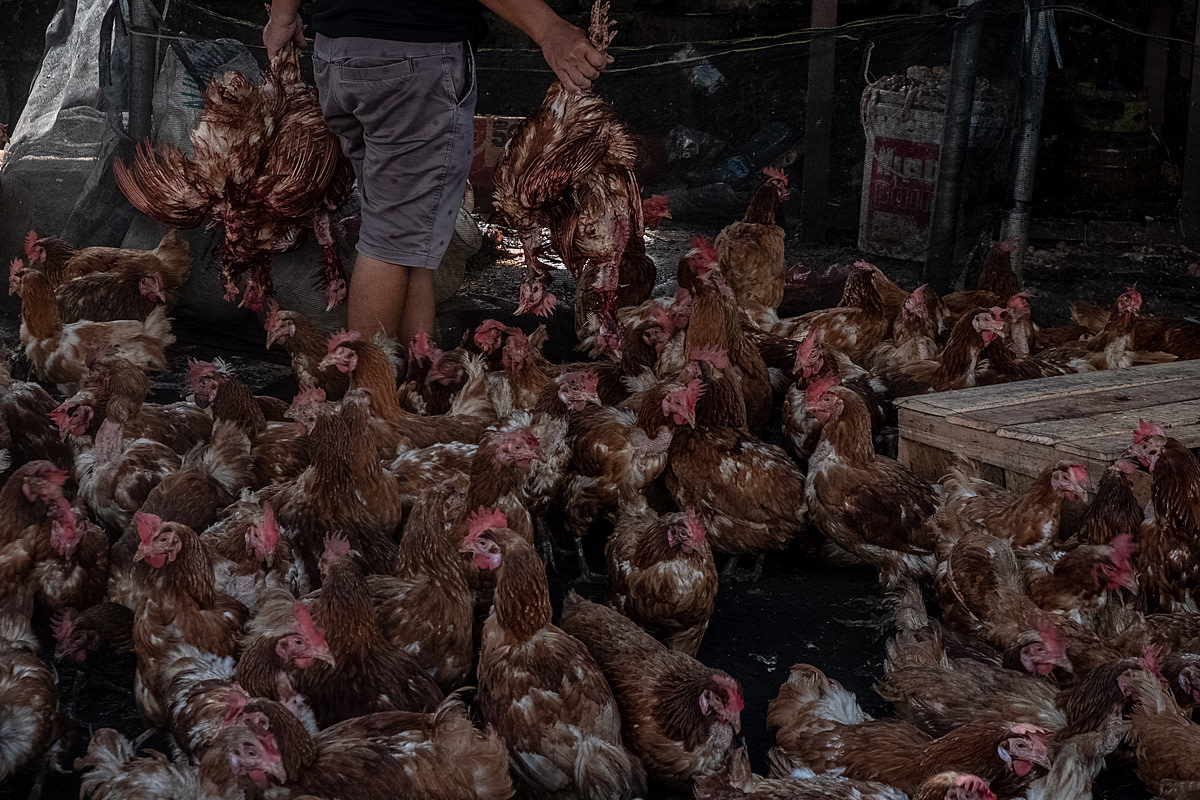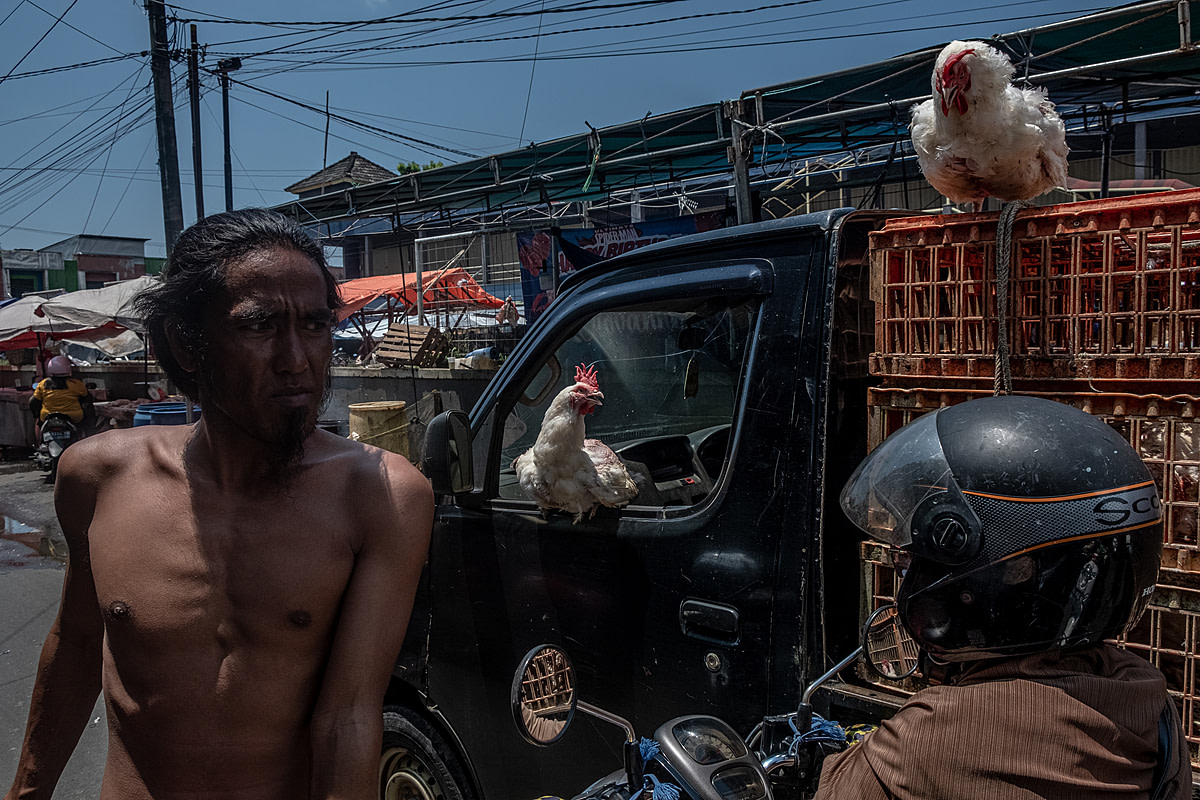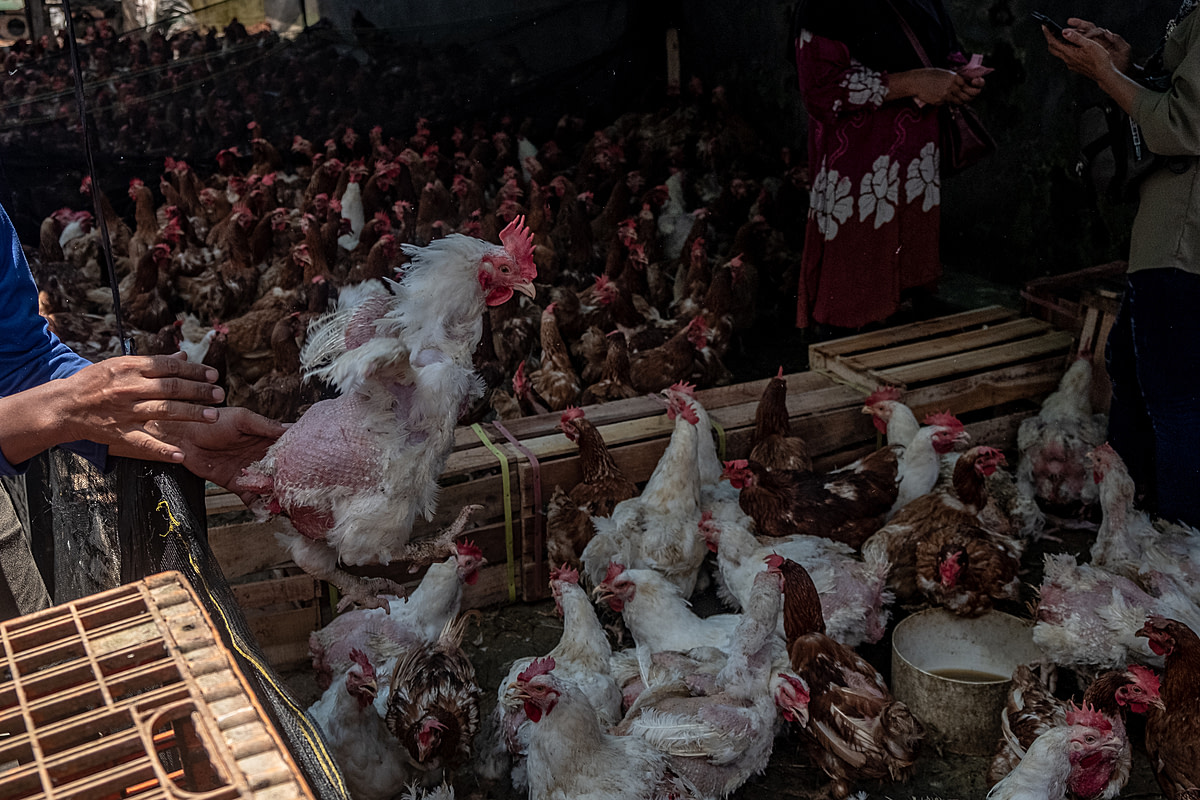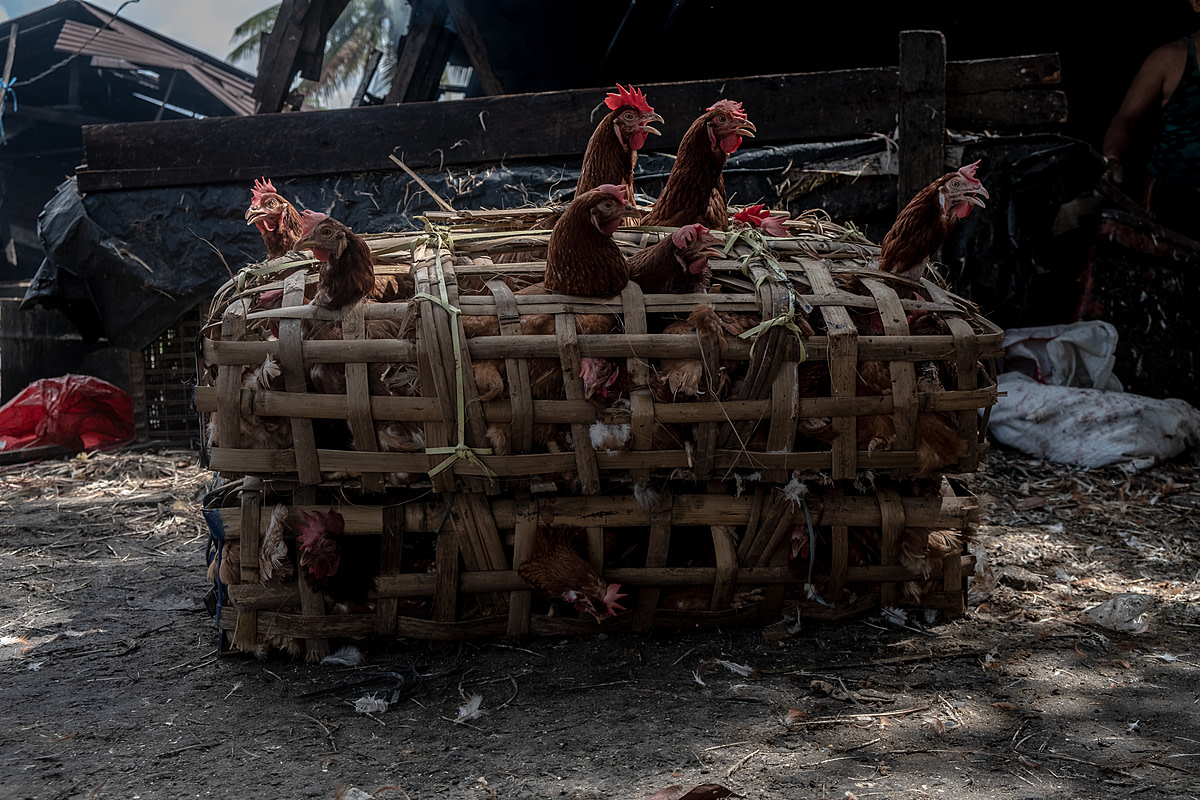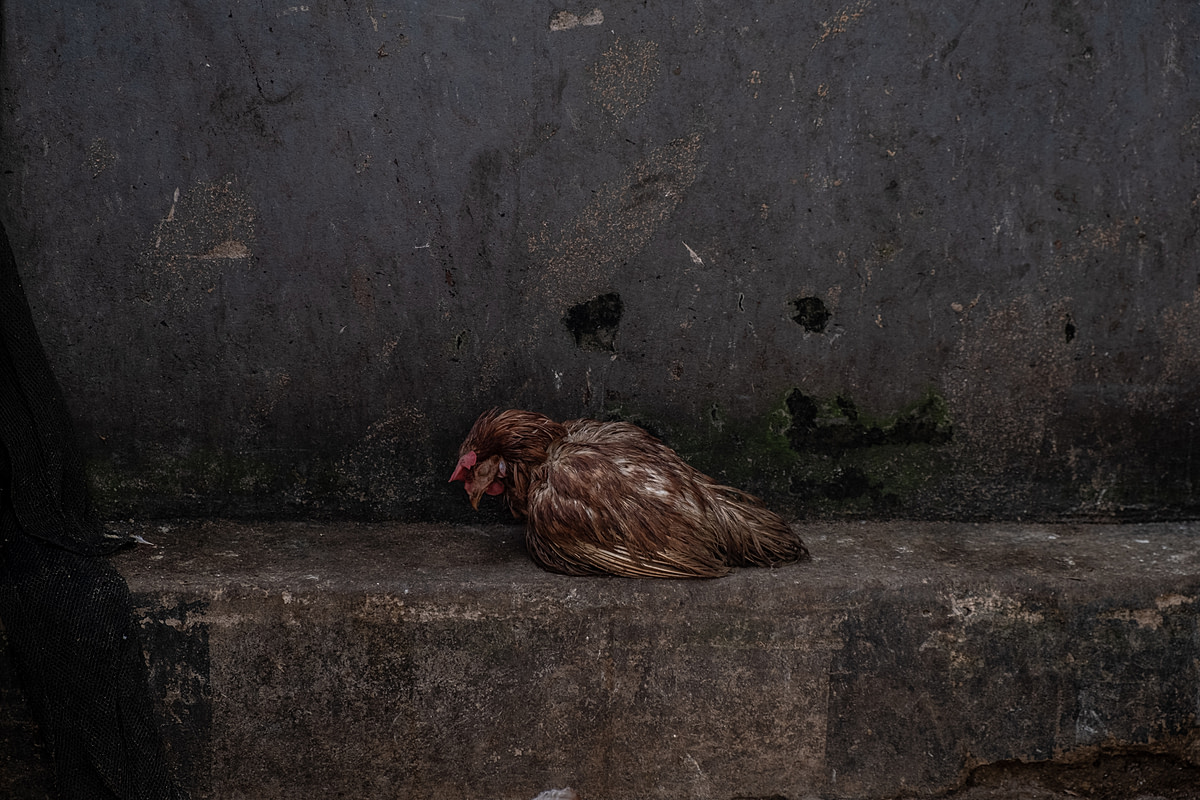In the days before the Eid al-Fitr holiday, a buyer at an Indonesian market grasps a chicken by their legs, chosen for purchase from the countless birds crowded inside a seller’s stall. Indonesia, 2023.
Resha Juhari / We Animals
Last month, We Animals photojournalist Resha Juhari was on assignment in Indonesia’s Bangka Belitung Province to document the increase in sales of “broiler” chickens in the lead up to the Islamic holiday Eid al-Fitr. Resha’s photographs are a startling glimpse into the lives of the many thousands of birds who are sourced and sold for human consumption at Indonesia’s traditional markets.
Photographer: Resha Juhari
At an Indonesian market before the Eid al-Fitr holiday, a chicken investigates the body of a slaughtered chicken soaking in a tub of hot water before being defeathered. As Eid al-Fitr nears, customer demand for chicken meat markedly increases preceding the holiday celebrations. Pagi Market, Pangkalpinang, Bangka Belitung, Indonesia, 2023.
Resha Juhari / We Animals
“I have been photographing chicken sales in lead up to Eid al-Fitr for as long as I have been working as a photojournalist, which is about 10 years. The situation has not changed; it’s the same as in previous years. This sale and massive slaughtering of chickens only happens on religious holidays such as Eid al-Fitr. The conditions of the markets that sell chickens is still the same; chickens are gathered for sale and are not fed, only watered during this period.” ― Resha Juhari, animal photojournalist
Eid al-Fitr Celebrations in Indonesia
The increase in broiler chicken sales is due to a higher consumption of chicken during Eid al-Fitr celebrations at the conclusion of Ramadan, a month-long fast undertaken by the Muslim community. During the day leading up to Eid al-Fitr, chicken vendors can sell up to 200 to 300 birds who are sourced from various regions in Bangka Belitung and Palembang, and sold in traditional markets. In Pangkalpinang City, there are three traditional markets where people go to buy chicken: Pembangunan Market, Pagi Market, and Trem Market.
In the days before the Eid al-Fitr holiday, shoppers at a busy Indonesian market cover their noses to avoid the strong smell emanating from a chicken seller’s stall. As Eid al-Fitr nears, customer demand for chicken meat markedly increases preceding the holiday celebrations. Pagi Market, Pangkalpinang, Bangka Belitung, Indonesia, 2023.
Resha Juhari / We Animals
As Eid al-Fitr approaches, at an Indonesian market a chicken peers through the wire of a crowded cage as a child looks on. Demand for chickens to consume during Eid al-Fitr celebrations rises noticeably as the holiday nears. Trem Market, Pangkalpinang, Bangka Belitung, Indonesia, 2023.
Resha Juhari / We Animals
Vendors take advantage of this busy period to sell their chickens, typically starting one week before the holiday. The high demand for chicken before Eid al-Fitr has led to the emergence of many traders. Chicken sales not only take place in markets but also on roadsides in Pangkalpinang City. Traders sell birds for about 60,000 Indonesian rupiahs (about $4 USD). While households usually only buy one to two chickens at a time, for Eid al-Fitr they tend to purchase more than three.
“All three of the markets I visited had the same smell. Dirty slaughterhouses mixed with blood, discarded body parts, feathers and dead chicken bodies scattered for days on end caused the smell. You can imagine what it was like.” ― Resha Juhari
At a busy Indonesian market in the days before the Eid al-Fitr holiday, dead chickens hang above a seller’s counter as the seller cuts up animal body parts and interacts with shoppers in the background. As Eid al-Fitr nears, customer demand for chicken meat markedly increases preceding the holiday celebrations. Pagi Market, Pangkalpinang, Bangka Belitung, Indonesia, 2023.
Resha Juhari / We Animals
On a day preceding the Eid al-Fitr holiday, a chicken arriving at a seller’s stall is dropped into a crowded enclosure at an Indonesian market. As Eid al-Fitr nears, broiler chicken sales markedly increase due to customer demand for chicken meat during the holiday celebrations. Pembangunan Market, Pangkalpinang, Bangka Belitung, Indonesia, 2023.
Resha Juhari / We Animals
In the days before the Eid al-Fitr holiday, a seller at an Indonesian market picks up slaughtered chickens from a dirty floor to move them to a defeathering area. As Eid al-Fitr nears, customer demand for chicken meat markedly increases preceding the holiday celebrations. Pagi Market, Pangkalpinang, Bangka Belitung, Indonesia, 2023.
Resha Juhari / We Animals
The Spread of Avian Influenza (H5N1) in Indonesia
Avian influenza (H5N1), more commonly referred to as bird flu, continues to spread at an alarming rate among wild and domesticated bird populations. Despite this, the connection between intensively farmed animals and disease transmission remains underreported. Cramped and busy market environments like the ones Resha visited on this assignment are the perfect breeding grounds for this highly pathogenic virus.
“In the last few months, bird flu cases have been spreading in several regions in Indonesia. I hope there is a special role from the relevant authorities in responding to this case, so that it does not cause serious concern to the public, especially during Eid al-Fitr when chicken consumption increases” ― Resha Juhari
In the days before the Eid al-Fitr holiday, market visitors view countless chickens crowded inside a seller’s stall. As Eid al-Fitr nears, customer demand for chicken meat markedly increases preceding the holiday celebrations. Pagi Market, Pangkalpinang, Bangka Belitung, Indonesia, 2023.
Resha Juhari / We Animals
To date, the spread of bird flu within farmed bird populations has been found in several regions of Indonesia. In March 2023, local media reported on cases of infected birds on farms in South Kalimantan Province, Central Cimahi District, Cimahi City and West Java Province. According to data from the Food and Agriculture Service of Cimahi City, a total of 172 birds have been exposed to the virus, of which 49 died.
The Ministry of Health of the Republic of Indonesia states that H5N1 entered Indonesia and began to spread in humans in 2005. There have been no reports of human cases so far during this current outbreak but government health officials buckle down with awareness-raising, urging the public to remain cautious.
At a busy Indonesian market in the days before the Eid al-Fitr holiday, a seller carries several chickens upside down as he walks through a crowd of chickens inside his stall. As Eid al-Fitr nears, customer demand for chicken meat markedly increases preceding the holiday celebrations. Pagi Market, Pangkalpinang, Bangka Belitung, Indonesia, 2023.
Resha Juhari / We Animals
On a day preceding the Eid al-Fitr holiday, escaped chickens sit on a small transport truck at an Indonesian market. As Eid al-Fitr nears, broiler chicken sales markedly increase due to customer demand for chicken meat during the holiday celebrations. Pembangunan Market, Pangkalpinang, Bangka Belitung, Indonesia, 2023.
Resha Juhari / We Animals
The Emotional Lives of Chickens
Globally, birds raised for meat are treated as units of production and with disregard for their emotional and physiological needs. Whether inside the factory farm, en route to the slaughterhouse, or at the local market, they are jostled, thrown and strung towards a violent and inevitable end.
On a day preceding the Eid al-Fitr holiday, a chicken arriving at a seller’s stall is dropped into a crowded enclosure at an Indonesian market. As Eid al-Fitr nears, broiler chicken sales markedly increase due to customer demand for chicken meat during the holiday celebrations. Pembangunan Market, Pangkalpinang, Bangka Belitung, Indonesia, 2023.
Resha Juhari / We Animals
Before the Eid al-Fitr holiday, a buyer at an Indonesian market holds a live chicken by their wings as they bring them to a slaughter and de-feathering area. As Eid al-Fitr nears, broiler chicken sales markedly increase due to customer demand for chicken meat during the holiday celebrations. Pembangunan Market, Pangkalpinang, Bangka Belitung, Indonesia, 2023.
Resha Juhari / We Animals
As Eid al-Fitr approaches, chickens for sale for slaughter are tightly confined inside a basket at an Indonesian market and poke their head through its openings. Demand for chickens to consume during Eid al-Fitr celebrations rises noticeably as the holiday nears. Trem Market, Pangkalpinang, Bangka Belitung, Indonesia, 2023.
Resha Juhari / We Animals
At the markets Resha visited on this assignment, birds trembled in fear while surrounded by the sights and sounds of their peers being “prepared” for sale. Others languished alone amidst the chaos, clearly suffering both physically and psychologically.
“My experience with chickens for more than twenty years has shown me that they are conscious and emotional beings with adaptable sociability and a range of intentions and personalities. If there is one trait above all that leaps to my mind in thinking about chickens when they are enjoying their lives and pursuing their own interests, it is cheerfulness. Chickens are cheerful birds, quite vocally so, and when they are dispirited and oppressed, their entire being expresses this state of affairs as well.” — Karen Davis, President of United Poultry Concerns
A weak chicken languishes alone on a bare concrete wall at an Indonesian market stall that sells chickens in the days preceding the Eid al-Fitr holiday. As Eid al-Fitr nears, broiler chicken sales markedly increase due to customer demand for chicken meat during the holiday celebrations. Pembangunan Market, Pangkalpinang, Bangka Belitung, Indonesia, 2023.
Resha Juhari / We Animals
Data sources: Sulteng Antara News / Detikjabar / Healthy Negeriku / The Jakarta Post / United Poultry Concerns
Photographer: Resha Juhari
Explore and download visuals from this assignment via our stock platform, which offers 30,000+ images and video clips for free to anyone helping animals.

